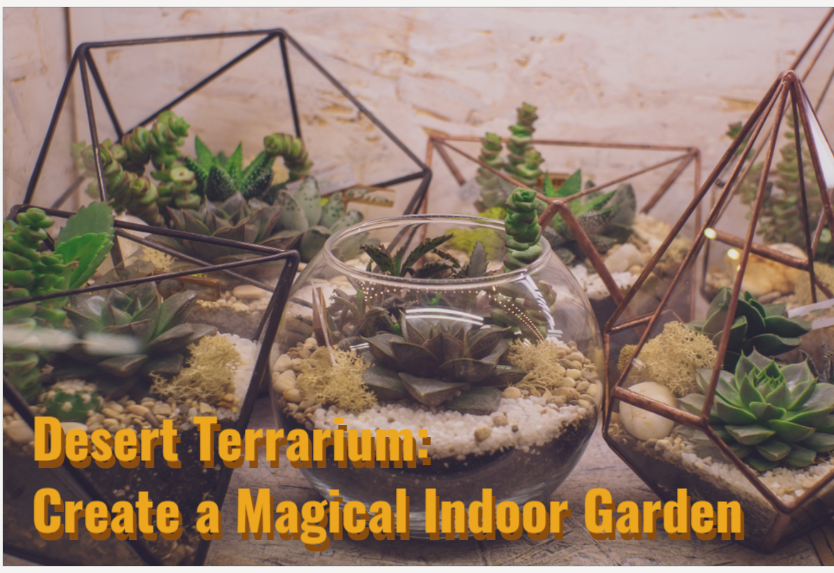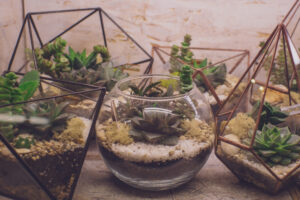HousePlantJoy is supported by our audience. When you purchase through one of our links, we may earn a small affiliate commission. As an Amazon Associate I earn from qualifying purchases. Your cost is not affected.
==================
Indoor plants are magical as they play an essential role in the design and feel of a space. They are also an incredible way for people without a yard to stay connected to nature. This post will discuss desert terrariums and everything related to them.
Whenever we heard the word “desert,” we envision a sandy, dry, and very hot expanse of vast and wilderness. But upon closer investigation, you will find it an intricate and vibrant biome containing a diverse range of animals and plants.
These desert animals and plants have adapted to life in the extreme desert environment. Due to the dryness and excessive heat, these species have adapted in unique ways. Although escaping the sun’s heat is essential for survival, sun rays also deliver mineral and vitamin processing abilities.
Unveiling the Imbalance: An Unparalleled Contrast Between Two Desert Worlds
The first desert type is rocky deserts, with low temperatures and higher humidity levels. The second type is sandy deserts, which have incredibly higher temperatures and low humidity levels. So, knowing the difference between them determines the success or failure of the desert terrarium’s endeavor.
It means creating a desert terrarium where all the natural elements live in harmony can be a challenging but enriching task. Moreover, since the desert terrariums need a lot of light, ensure that you have adequate light.
However, there is no doubt that creating a desert terrarium is fun, and it also doesn’t need much care. You can plant a variety of succulents and cacti, which can easily tolerate the sunlight while also don’t need much water. Furthermore, unlike other terrariums that I have discussed in my previous articles, you can create the desert terrariums in an open dish instead of closed containers.
Here is a step-by-step guide to making an inexpensive and adorable desert terrarium.
List of Materials You Will Need to Make a Desert Terrarium
- Glass container (preferably 8” in height and 7” in diameter).
- Plants like cacti or succulents. (You can also use other types of desert plants).
- Bag sand. However, avoid using beach sand because of contaminants.
- Potting soil. (Makes sure it is enough and will entirely cover the plant roots).
- Activated charcoal. (It is helpful to keep the desert terrarium odor-free and clean all the time).
- Colorful stones of different shapes. (These are for the decoration of your desert terrarium).
- Aquarium gravel. (will act as drainage for your terrarium).
Procedure to Make a Desert Terrarium
1. Take the Glass Container
Many begin with a glass container measuring 8″ in height and 7″ in diameter. However, you can also use any other size container.
2. Fill It With Aquarium Gravel
Once a suitable container is ready, fill the base with aquarium gravel – at least two inches deep works best.
3. Create a Layer of Activated Charcoal
Once you have filled the base with aquarium gravel, create a layer of activated charcoal. Creating the layer of activated charcoal will help to keep your terrarium fresh and clean.
4. Add Potting Soil
The next step is to place potting soil. Ensure you add enough potting soil to cover the plant’s roots well.
5. Add Your Plant(s)
Once you have added enough potting soil in the desert terrarium, it’s time to plant your cacti or succulents. You can plant any other desert plants as well. In this regard, dig inside the potting soil and gently place your plant inside the terrarium. If you’ve more than one plant to grow, you can arrange their positions as per your choice.
6. Decorate Your Desert Terrarium
Now, your desert terrarium is ready. All you need now is to decorate it by adding sand and colorful stones of different shapes. Your inexpensive but adorable desert terrarium is ready that you can place on your tabletop.
How to Care Desert Terrarium?
The rule of thumb for dessert terrariums is to water the plants thoroughly and then wait long enough to ensure the soil is completely dried out before watering again. Succulents and other desert plants can easily tolerate drier conditions. But still, make sure not to let them become bone dry.
Note: In summer, you should check the soil dryness after every two weeks. While in winter, check the dryness of your desert terrarium soil every three to four weeks.
Some other essential points that you should keep in mind include:
- Do not water over the succulents. Also, remember that they don’t like to be misted.
- When watering, make the water is non-chlorinated. See our article on water types here.
- Try moving the plant to a bit brighter place if succulents start to bend in one direction.
Best Plants for Desert Terrarium
1. Ghost Plant Succulent
These low-maintenance desert plants are common. The shape of these plants is similar to a rose. These are also nice for along pathways, garden borders, rock gardens, and desert terrariums.
Care Needs
- They need well-drained soil.
- Water them moderately.
- Ensure the potting soil is dry several inches before watering them.
2. Flaming Katy
Flaming Katy plants exist in various colors and delivers puffy, bright, and long-lasting flowers. It is a lovely desert plant for your desert landscape. Flaming Katy is a gorgeous specimen and can easily be found in the floral gift section of supermarkets. The maximum height of the flaming Katy is 12 inches.
Care Needs
- Apply water from the base.
- Make sure the potting soil is dried out completely before watering them again.
- Avoid water spotting on the leaves.
3. Zebra Cactus
Zebra Cactus plant could be another lovely addition to your desert terrarium. It is an extremely low-growing desert plant and is often compared to aloe. Although it is a low-caring plant to grow, keep it protected from direct sunlight.
Care Needs
- – Protect them from direct sunlight and very shady areas.
- – Water them moderately. Once a week in summer and every two weeks in winter.
- – Fertilize once every three months.
4. Golden Barrel
The name of this cactus perfectly describes its bulbous shape. The golden yellow spines make it a striking centerpiece in all types of desert landscapes. From the top of the cactus barrel, its vivid flowers bloom. It is also an incredibly slow-growing cactus and can live for a long time.
Care Needs
- – Water them frequently.
- – They don’t like wet feet.
- – Drench the soil to let it dry between watering.
5. Fox Tail Agave
Although you will find plenty of agave species when shopping for desert plants, Fox Tail is probably the most popular among them. Its pleasant curved leaves burst like fireworks. When fully matured, its leaves will curl downward, and a large stalk will grow from the center of the plant. It is perennial, which means it looks lovely year-round.
Care Needs
- It likes well-drained soil.
- This plant likes to get water regularly.
- It likes to get full sunlight, but you should protect it from excessive heat.
Wrapping Up
That is how you can make a beautiful and inexpensive desert terrarium. Making a desert terrarium is simple and can be done in simple steps. I’ve also listed the best desert plants you may want to grow once your desert terrarium is ready.
FAQs
Can I plant cacti in a desert terrarium?
Although both cacti and succulents don’t like humid environments, they can still thrive in terrariums. However, you should ensure to pick a terrarium without a lid.
How many types of succulents are there?
Experts believe that over 10,000 varieties of succulents exist. Growers continue to showcase new succulents each year.
Discover the Green Oasis: Join Us on Social Media!
? Delve into the world of indoor and outdoor gardening, explore captivating content, and connect with a passionate community. ?
? Facebook: Houseplant Joy on Facebook ? Instagram: Follow us on Instagram ? Pinterest: Inspiration awaits on Pinterest ? Twitter: Join the conversation on Twitter
? Get ready to grow, nurture, and flourish with Houseplant Joy – your ultimate gardening companion. ?
Read More





